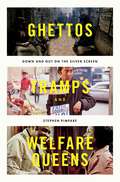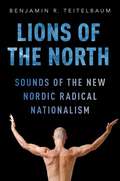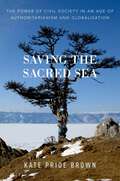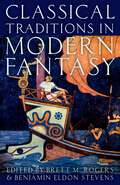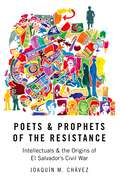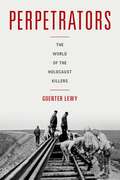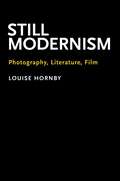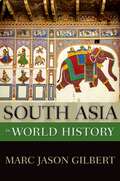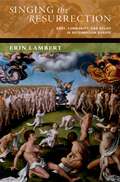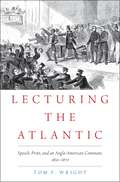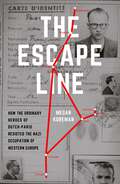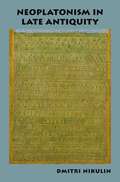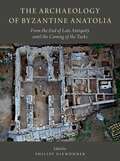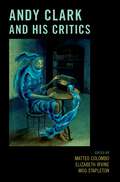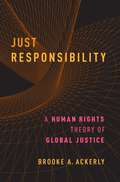- Table View
- List View
Ghettos, Tramps, and Welfare Queens: Down and Out on the Silver Screen
by Stephen PimpareGhettos, Tramps, and Welfare Queens: Down & Out on the Silver Screen explores how American movies have portrayed poor and homeless people from the silent era to today. It provides a novel kind of guide to social policy, exploring how ideas about poor and homeless people have been reflected in popular culture and evaluating those images against the historical and contemporary reality. Richly illustrated and examining nearly 300 American-made films released between 1902 and 2015, Ghettos, Tramps, and Welfare Queens finds and describes representations of poor and homeless people and the places they have inhabited throughout the century-long history of U.S. cinema. It moves beyond the merely descriptive to deliberate whether cinematic representations of homelessness and poverty changed over time, and if there are patterns to be discerned. Ultimately, the text offers a preliminary response to a handful of harder questions about causation and consequence: Why are these portrayals as they are? Where do they come from? Are they a reflection of American attitudes and policies toward marginalized populations, or do they help create them? What does this all mean for politics and policymaking? Of interest to movie buffs and film scholars, cultural critics and historians, policy analysts, and those curious to know more about homelessness and American poverty, Ghettos, Tramps, and Welfare Queens is a unique window into American politics, history, policy, and culture -- it is an entertaining and enlightening journey.
Ghettos, Tramps, and Welfare Queens: Down and Out on the Silver Screen
by Stephen PimpareGhettos, Tramps, and Welfare Queens: Down & Out on the Silver Screen explores how American movies have portrayed poor and homeless people from the silent era to today. It provides a novel kind of guide to social policy, exploring how ideas about poor and homeless people have been reflected in popular culture and evaluating those images against the historical and contemporary reality. Richly illustrated and examining nearly 300 American-made films released between 1902 and 2015, Ghettos, Tramps, and Welfare Queens finds and describes representations of poor and homeless people and the places they have inhabited throughout the century-long history of U.S. cinema. It moves beyond the merely descriptive to deliberate whether cinematic representations of homelessness and poverty changed over time, and if there are patterns to be discerned. Ultimately, the text offers a preliminary response to a handful of harder questions about causation and consequence: Why are these portrayals as they are? Where do they come from? Are they a reflection of American attitudes and policies toward marginalized populations, or do they help create them? What does this all mean for politics and policymaking? Of interest to movie buffs and film scholars, cultural critics and historians, policy analysts, and those curious to know more about homelessness and American poverty, Ghettos, Tramps, and Welfare Queens is a unique window into American politics, history, policy, and culture -- it is an entertaining and enlightening journey.
LIONS OF THE NORTH C: Sounds of the New Nordic Radical Nationalism
by Benjamin R. TeitelbaumOften labeled "neo-Nazis" or "right-wing extremists," radical nationalists in the Nordic countries have always relied on music to voice their opposition to immigration and multiculturalism. These actors shook political establishments throughout Sweden, Denmark, and Norway during the 1980s and 1990s by rallying around white power music and skinhead subculture. But though nationalists once embraced a reputation for crude chauvinism, they are now seeking to reinvent themselves as upstanding and righteous, and they are using music to do it. Lions of the North explores this transformation of anti-immigrant activism in the Nordic countries as it manifests in thought and sound. Offering a rare ethnographic glimpse into controversial and secretive political movements, it investigates changes in the music nationalists make and patronize, reading their puzzling embrace of lite pop, folk music, even rap and reggae as attempts to escape stereotypes and craft a new image for themselves. Lions of the North not only exposes the dynamic relationship between music and politics, but also the ways radical nationalism is adapting to succeed in some of the most liberal societies in the world.
Saving the Sacred Sea: The Power of Civil Society in an Age of Authoritarianism and Globalization
by Kate Pride Brown"Civil society" is a loaded concept in Russia; during the Soviet period, the voices that heralded civil society were the same ones that demanded the Union's dissolution. So, for the Kremlin, civil society is not the guarantor of democracy, but a force that has the power to end governments. This book looks at how civil society negotiates power on a global stage, under Russia's authoritarian regime, and in a particularly isolated and remote part of the world: within environmental activism around Lake Baikal in Siberia. More than a mile deep, Lake Baikal is the oldest, deepest, and most voluminous lake on the Earth, and home to thousands of endemic species. It is also ecologically unique in that it is oxygenated to its maximum depth and supports life even at the lake floor -- a phenomenon occurring nowhere else on the planet. The lake is not just a natural wonder, but home to a strong environmentalist community that works tirelessly to protect the lake from human harm. Environmentalism at Baikal began in the late 1950s, eventually igniting the first national protest in the USSR. They have remained active in some form ever since, across the years of chaos, instability, and crisis, from the opening of Russia to the forces of globalization to the authoritarianism of Putin in the present. This book examines the struggle of Baikal environmentalists to develop a new understanding of civil society under conditions of globalization and authoritarianism. Through extended, historically-informed ethnographic analysis, Kate Pride Brown argues that civil society is engaged with political and economic elites in a dynamic struggle within a field of power. Understanding the field of power helps to explain a number of contradictions. For example, why does civil society seem to both bolster democracy and threaten it? Why do capitalist corporations and environmental organizations form partnerships despite their general hostility toward each other? And why has democracy proven to be so elusive in Russia? The field of power posits new answers to these questions, as Baikal environmental activists struggle to protect and save their Sacred Sea.
SAVING THE SACRED SEA C: The Power of Civil Society in an Age of Authoritarianism and Globalization
by Kate Pride Brown"Civil society" is a loaded concept in Russia; during the Soviet period, the voices that heralded civil society were the same ones that demanded the Union's dissolution. So, for the Kremlin, civil society is not the guarantor of democracy, but a force that has the power to end governments. This book looks at how civil society negotiates power on a global stage, under Russia's authoritarian regime, and in a particularly isolated and remote part of the world: within environmental activism around Lake Baikal in Siberia. More than a mile deep, Lake Baikal is the oldest, deepest, and most voluminous lake on the Earth, and home to thousands of endemic species. It is also ecologically unique in that it is oxygenated to its maximum depth and supports life even at the lake floor -- a phenomenon occurring nowhere else on the planet. The lake is not just a natural wonder, but home to a strong environmentalist community that works tirelessly to protect the lake from human harm. Environmentalism at Baikal began in the late 1950s, eventually igniting the first national protest in the USSR. They have remained active in some form ever since, across the years of chaos, instability, and crisis, from the opening of Russia to the forces of globalization to the authoritarianism of Putin in the present. This book examines the struggle of Baikal environmentalists to develop a new understanding of civil society under conditions of globalization and authoritarianism. Through extended, historically-informed ethnographic analysis, Kate Pride Brown argues that civil society is engaged with political and economic elites in a dynamic struggle within a field of power. Understanding the field of power helps to explain a number of contradictions. For example, why does civil society seem to both bolster democracy and threaten it? Why do capitalist corporations and environmental organizations form partnerships despite their general hostility toward each other? And why has democracy proven to be so elusive in Russia? The field of power posits new answers to these questions, as Baikal environmental activists struggle to protect and save their Sacred Sea.
CLASSICAL TRADITIONS IN MODERN FANTASY C
by Brett M. Rogers and Benjamin Eldon StevensClassical Traditions in Modern Fantasy is the first collection of essays in English focusing on how fantasy draws deeply on ancient Greek and Roman mythology, philosophy, literature, history, art, and cult practice. Presenting fifteen all-new essays intended for both scholars and other readers of fantasy, this volume explores many of the most significant examples of the modern genre-including the works of H. P. Lovecraft, J. R. R. Tolkien's The Hobbit, C. S. Lewis's Chronicles of Narnia, J. K. Rowling's Harry Potter series, George R. R. Martin's Game of Thrones series, and more-in relation to important ancient texts such as Aeschylus' Oresteia, Aristotle's Poetics, Virgil's Aeneid, and Apuleius' The Golden Ass. These varied studies raise fascinating questions about genre, literary and artistic histories, and the suspension of disbelief required not only of readers of fantasy but also of students of antiquity. Ranging from harpies to hobbits, from Cyclopes to Cthulhu, and all manner of monster and myth in-between, this comparative study of Classics and fantasy reveals deep similarities between ancient and modern ways of imagining the world. Although antiquity and the present day differ in many ways, at its base, ancient literature resonates deeply with modern fantasy's image of worlds in flux and bodies in motion.
Poets and Prophets of the Resistance: Intellectuals and the Origins of El Salvador's Civil War
by Joaquín M. ChávezPoets and Prophets of the Resistance offers a ground-up history and fresh interpretation of the polarization and mobilization that brought El Salvador to the eve of civil war in 1980. Challenging the dominant narrative that university students and political dissidents primarily formed the Salvadoran guerrillas, Joaquín Chávez argues that El Salvador's socioeconomic and political crises of the 1970s fomented a groundswell of urban and peasant intellectuals who collaborated to spur larger revolutionary social movements. Drawing on new archival sources and in-depth interviews, Poets and Prophets of the Resistance contests the idea that urban militants and Roman Catholic priests influenced by Liberation Theology single-handedly organized and politicized peasant groups. Chávez shows instead how peasant intellectuals acted as political catalysts among their own communities first, particularly in the region of Chalatenango, laying the groundwork for the peasant movements that were to come. In this way, he contends, the Salvadoran insurgency emerged in a dialogue between urban and peasant intellectuals working together to create and execute a common revolutionary strategy--one that drew on cultures of resistance deeply rooted in the country's history, poetry, and religion. Focusing on this cross-pollination, this book introduces the idea that a "pedagogy of revolution" originated in this historical alliance between urban and peasant, making use of secular and Catholic pedagogies such as radio schools, literacy programs, and rural cooperatives. This pedagogy became more and more radicalized over time as it pushed back against the increasingly repressive structures of 1970s El Salvador. Teasing out the roles of little-known groups such as the politically active "La Masacuata" literary movement, the contributions of Catholic Action intellectuals to the New Left, and the overlooked efforts of peasant leaders, Poets and Prophets of the Resistance demonstrates how trans-class political and cultural interactions drove the revolutionary mobilizations that anticipated the Salvadoran civil war.
Perpetrators: The World of the Holocaust Killers
by Guenter Lewy"Monsters exist, but they are too few in number to be truly dangerous. More dangerous are the common men, the functionaries ready to believe and to act without asking questions." Primo Levi's words disclose a chilling truth: assigning blame to hideous political leaders, such as Hitler, Himmler, and Heydrich, is necessary but not sufficient to explain how the Holocaust could have happened. These leaders, in fact, relied on many thousands of ordinary men and women who made the Nazi machine work on a daily basis--members of the killing squads, guards accompanying the trains to the extermination camps, civilian employees of the SS, the drivers of gas trucks, and the personnel of death factories such as Auschwitz. Why did these ordinary people collaborate and willingly become mass murderers? In Perpetrators: The World of the Holocaust Killers, Guenter Lewy tries to answer one of history's most disturbing questions. Lewy draws on a wealth of previously untapped sources, including letters and diaries of soldiers who served in Russia, the recollections of Jewish survivors, archival documents, and most importantly, the trial records of hundreds of Nazi functionaries. The result is a ghastly, extraordinarily detailed portrait of the Holocaust perpetrators, their mindset, and the motivations for their actions. Combining a rigorous historical analysis with psychological insight, the book explores the dynamics of participation in large-scale atrocities, offering a thought-provoking and timely reflection on individual responsibility for collective crimes. Lewy concludes that the perpetrators acted out of a variety of motives--a sense of duty, obedience to authority, thirst for career, and a blind faith in anti-Semitic ideology, among others. A witness to the 1938 Kristallnacht himself and the son of a concentration camp survivor, Lewy has searched for the reasons of the Holocaust out of far more than theoretical interest: it is a passionate attempt to illuminate a dismal chapter of his life--and of human history--that cannot be forgotten.
Perpetrators: The World of the Holocaust Killers
by Guenter Lewy"Monsters exist, but they are too few in number to be truly dangerous. More dangerous are the common men, the functionaries ready to believe and to act without asking questions." Primo Levi's words disclose a chilling truth: assigning blame to hideous political leaders, such as Hitler, Himmler, and Heydrich, is necessary but not sufficient to explain how the Holocaust could have happened. These leaders, in fact, relied on many thousands of ordinary men and women who made the Nazi machine work on a daily basis--members of the killing squads, guards accompanying the trains to the extermination camps, civilian employees of the SS, the drivers of gas trucks, and the personnel of death factories such as Auschwitz. Why did these ordinary people collaborate and willingly become mass murderers? In Perpetrators: The World of the Holocaust Killers, Guenter Lewy tries to answer one of history's most disturbing questions. Lewy draws on a wealth of previously untapped sources, including letters and diaries of soldiers who served in Russia, the recollections of Jewish survivors, archival documents, and most importantly, the trial records of hundreds of Nazi functionaries. The result is a ghastly, extraordinarily detailed portrait of the Holocaust perpetrators, their mindset, and the motivations for their actions. Combining a rigorous historical analysis with psychological insight, the book explores the dynamics of participation in large-scale atrocities, offering a thought-provoking and timely reflection on individual responsibility for collective crimes. Lewy concludes that the perpetrators acted out of a variety of motives--a sense of duty, obedience to authority, thirst for career, and a blind faith in anti-Semitic ideology, among others. A witness to the 1938 Kristallnacht himself and the son of a concentration camp survivor, Lewy has searched for the reasons of the Holocaust out of far more than theoretical interest: it is a passionate attempt to illuminate a dismal chapter of his life--and of human history--that cannot be forgotten.
Still Modernism: Photography, Literature, Film
by Louise HornbyStill Modernism offers a critique of the modernist imperative to embrace motion, speed, and mobility. In the context of the rise of kinetic technologies and the invention of motion pictures, it claims that stillness is nonetheless an essential tactic of modernist innovation. More specifically, the book looks at the ways in which photographic stillness emerges as a counterpoint to motion and to film, asserting its own clear visibility against the blur of kinesis. Photographic stillness becomes a means to resist the ephemerality of motion and to get at and articulate something real or essential by way of its fixed limits. Combining art history, film studies and literary studies, Louise Hornby reveals how photographers, filmmakers, and writers, even at their most kinetic, did not surrender attention to points of stillness. Rather, the still image, understood through photography, establishes itself as a mode of resistance and provides a formal response to various modernist efforts to see better, to attend more closely, and to remove the fetters of subjectivity and experience. Still Modernism brings together a series of canonical texts, films, and photographs, the selection of which reinforces the central claim that stillness does not lurk at the margins of modernism, but was constitutive of its very foundations. In a series of comparisons drawing from literary and visual objects, Hornby argues that still photography allows film to access its own diffuse images of motion; photography's duplicative form provides a serial structure for modernist efforts to represent the face; its iterative structure articulates the jerky rhythms of experimental narrative as perambulation; and its processes of development allow for the world to emerge independent of the human observer. Casting new light on the relationship between photography and film, Hornby situates the struggle between the still and the kinetic at the center of modernist culture.
South Asia in World History (New Oxford World History)
by Marc Jason GilbertFew regions have shaped the world's history as deeply as South Asia. The birthplace of three of the world's major religions-Hinduism, Buddhism, and Sikhism-the Indian subcontinent has made indelible contributions to the world, from foods such as curry and granulated sugar to the performance of meditation and yoga, from the architectural magnificence of the Taj Mahal to the binary system of numbers. In this accessible book, Marc Jason Gilbert takes us on a journey through South Asia's fascinating history, starting with the blossoming of the Harappan civilization in the fertile Indus valley more than four thousand years ago. Following the routes of the cotton, tea, and opium trade that connected the West and the East throughout history, Gilbert describes South Asia's classical Hindu and Buddhist empires, the coming of Islam to South Asia, the local impact of the Mongol invasions, the splendors of the Mughal Empire, the expansion of British colonial dominion, and the development of South Asian modern nations-Nepal, Pakistan, Bhutan, Bangladesh, India, the Maldives, and Myanmar-in the twentieth century. The book concludes with a timely reflection on the contradictory face of contemporary South Asia. Although the region has produced some of the world's most iconic leaders of non-violent protest-Mahatma Gandhi, Arundhati Roy, Mother Teresa, and Aung San Suu Kyi-severe social divisions and injustice persist in most South Asian countries. Simultaneously, extraordinary economic growth is deeply transforming South Asian societies and may enable them to rival the United States and China as the world's largest economies. Gilbert's transnational perspective illuminates how world historical processes-from changes in the environment and the economy to the movement of peoples and ideas-have shaped and continue to shape the history of South Asia and its place in the wider world.
South Asia in World History (New Oxford World History)
by Marc Jason GilbertFew regions have shaped the world's history as deeply as South Asia. The birthplace of three of the world's major religions-Hinduism, Buddhism, and Sikhism-the Indian subcontinent has made indelible contributions to the world, from foods such as curry and granulated sugar to the performance of meditation and yoga, from the architectural magnificence of the Taj Mahal to the binary system of numbers. In this accessible book, Marc Jason Gilbert takes us on a journey through South Asia's fascinating history, starting with the blossoming of the Harappan civilization in the fertile Indus valley more than four thousand years ago. Following the routes of the cotton, tea, and opium trade that connected the West and the East throughout history, Gilbert describes South Asia's classical Hindu and Buddhist empires, the coming of Islam to South Asia, the local impact of the Mongol invasions, the splendors of the Mughal Empire, the expansion of British colonial dominion, and the development of South Asian modern nations-Nepal, Pakistan, Bhutan, Bangladesh, India, the Maldives, and Myanmar-in the twentieth century. The book concludes with a timely reflection on the contradictory face of contemporary South Asia. Although the region has produced some of the world's most iconic leaders of non-violent protest-Mahatma Gandhi, Arundhati Roy, Mother Teresa, and Aung San Suu Kyi-severe social divisions and injustice persist in most South Asian countries. Simultaneously, extraordinary economic growth is deeply transforming South Asian societies and may enable them to rival the United States and China as the world's largest economies. Gilbert's transnational perspective illuminates how world historical processes-from changes in the environment and the economy to the movement of peoples and ideas-have shaped and continue to shape the history of South Asia and its place in the wider world.
Singing the Resurrection: Body, Community, and Belief in Reformation Europe (The New Cultural History of Music Series)
by Erin LambertSinging the Resurrection brings music to the foreground of Reformation studies, as author Erin Lambert explores song as a primary mode for the expression of belief among ordinary Europeans in the sixteenth century, for the embodiment of individual piety, and the creation of new communities of belief. Together, resurrection and song reveal how sixteenth-century Christians--from learned theologians to ordinary artisans, and Anabaptist martyrs to Reformed Christians facing exile--defined belief not merely as an assertion or affirmation but as a continuous, living practice. Thus these voices, raised in song, tell a story of the Reformation that reaches far beyond the transformation from one community of faith to many. With case studies drawn from each of the major confessions of the Reformation--Lutheran, Anabaptist, Reformed, and Catholic--Singing the Resurrection reveals sixteenth-century belief in its full complexity.
Singing the Resurrection: Body, Community, and Belief in Reformation Europe (The New Cultural History of Music Series)
by Erin LambertSinging the Resurrection brings music to the foreground of Reformation studies, as author Erin Lambert explores song as a primary mode for the expression of belief among ordinary Europeans in the sixteenth century, for the embodiment of individual piety, and the creation of new communities of belief. Together, resurrection and song reveal how sixteenth-century Christians--from learned theologians to ordinary artisans, and Anabaptist martyrs to Reformed Christians facing exile--defined belief not merely as an assertion or affirmation but as a continuous, living practice. Thus these voices, raised in song, tell a story of the Reformation that reaches far beyond the transformation from one community of faith to many. With case studies drawn from each of the major confessions of the Reformation--Lutheran, Anabaptist, Reformed, and Catholic--Singing the Resurrection reveals sixteenth-century belief in its full complexity.
Lecturing the Atlantic: Speech, Print, and an Anglo-American Commons 1830-1870
by Tom F. WrightIn the early nineteenth century, the public lecture emerged as one of the Anglo-American world's most important cultural forms. On both sides of the Atlantic, audiences and performers transformed a cultural practice with origins in the medieval cloister into an unexpected flashpoint medium of public life. In the United States, as part of the "lyceum movement," lecturing became crucial to literary and political life, multiple social reform movements, and the rise of public intellectualism, offering speakers from across the cultural spectrum a platform from which to promote their ideas and explain contemporary life. Lecturing the Atlantic argues for a new interpretation of this neglected institution. It reorients our understanding of the lyceum by seeing it as an international and cross-media phenomenon patterned by cultural investment in an "Anglo-American commons." Tom F. Wright shows how some of the mid-century North Atlantic world's most enduring cultural figures, such as Frederick Douglass, William Makepeace Thackeray, and Ralph Waldo Emerson, as well as fascinating marginal voices such as Lola Montez and John B. Gough, used lecture hall discussions of a transatlantic imaginary to offer powerful commentaries on slavery, progress, comedy, order, tradition, and reform. Crucially, this world was a matter as much of print as performance, since as the book reveals, a remarkable culture of newspaper commentary allowed oratory to resonate far beyond the realm of the lecture hall. Through a series of inventive readings of Anglo-American relations as understood through performance and print re-mediation, Wright connects the transatlantic turn in cultural studies to important recent debates in media theory and public sphere scholarship. Lecturing the Atlantic speaks to those interested in the literature and history of Victorian Britain and the early US, to students of performance, communication and rhetoric, and all those seeking a deeper understanding of nineteenth-century public culture.
The Escape Line: How the Ordinary Heroes of Dutch-Paris Resisted the Nazi Occupation of Western Europe
by Megan KoremanOf all the resistance organizations that operated during the war, about which much has been written, one stands out for its transnational character, the diversity of the tasks its members took on, and the fact that, unlike many of the known evasion lines, it was not directed by Allied officers, but rather by group of ordinary citizens. Between 1942 and 1945, they formed a network to smuggle Dutch Jews and others targeted by the Nazis south into France, via Paris, and then to Switzerland. This network became known as the Dutch-Paris Escape Line, eventually growing to include 300 people and expanding its reach into Spain. Led by Jean Weidner, a Dutchman living in France, many lacked any experience in clandestine operations or military tactics, and yet they became one of the most effective resistance groups of the Second World War. Dutch-Paris largely improvised its operations-scrounging for food on the black market, forging documents, and raising cash. Hunted relentlessly by the Nazis, some were even captured and tortured. In addition to Jews, those it helped escape the clutches of the Nazis included resistance fighters, political foes, Allied airmen, and young men looking to get to London to enlist. As the need grew more desperate, so did the bravery of those who rose to meet it. Using recently declassified archives, The Escape Line tells the story of the Dutch-Paris and the thousands of people it saved during World War II. Author Megan Koreman, who was given exclusive access to many of the archives, is herself the daughter of Dutch parents who were part of the resistance.
ESCAPE LINE C: How the Ordinary Heroes of Dutch-Paris Resisted the Nazi Occupation of Western Europe
by Megan KoremanOf all the resistance organizations that operated during the war, about which much has been written, one stands out for its transnational character, the diversity of the tasks its members took on, and the fact that, unlike many of the known evasion lines, it was not directed by Allied officers, but rather by group of ordinary citizens. Between 1942 and 1945, they formed a network to smuggle Dutch Jews and others targeted by the Nazis south into France, via Paris, and then to Switzerland. This network became known as the Dutch-Paris Escape Line, eventually growing to include 300 people and expanding its reach into Spain. Led by Jean Weidner, a Dutchman living in France, many lacked any experience in clandestine operations or military tactics, and yet they became one of the most effective resistance groups of the Second World War. Dutch-Paris largely improvised its operations-scrounging for food on the black market, forging documents, and raising cash. Hunted relentlessly by the Nazis, some were even captured and tortured. In addition to Jews, those it helped escape the clutches of the Nazis included resistance fighters, political foes, Allied airmen, and young men looking to get to London to enlist. As the need grew more desperate, so did the bravery of those who rose to meet it. Using recently declassified archives, The Escape Line tells the story of the Dutch-Paris and the thousands of people it saved during World War II. Author Megan Koreman, who was given exclusive access to many of the archives, is herself the daughter of Dutch parents who were part of the resistance.
Neoplatonism in Late Antiquity
by Dmitri NikulinThis book is a philosophical study of two major thinkers who span the period of late antiquity. While Plotinus stands at the beginning of its philosophical tradition, setting the themes for debate and establishing strategies of argument and interpretation, Proclus falls closer to its end, developing a grand synthesis of late ancient thought. The book discusses many central topics of philosophy and science in Plotinus and Proclus, such as the one and the many, number and being, the individuation and constitution of the soul, imagination and cognition, the constitution of number and geometrical objects, indivisibility and continuity, intelligible and bodily matter, and evil. It shows that late ancient philosophy did not simply embrace and borrow from the major philosophical traditions of earlier antiquity--Platonism, Aristotelianism, Stoicism--by providing marginal comments on widely-known philosophical texts. Rather, Neoplatonism offered a set of highly original and innovative insights into the nature of being and thought, which can be distinguished in much subsequent philosophical thought, up until modernity.
Neoplatonism in Late Antiquity
by Dmitri NikulinThis book is a philosophical study of two major thinkers who span the period of late antiquity. While Plotinus stands at the beginning of its philosophical tradition, setting the themes for debate and establishing strategies of argument and interpretation, Proclus falls closer to its end, developing a grand synthesis of late ancient thought. The book discusses many central topics of philosophy and science in Plotinus and Proclus, such as the one and the many, number and being, the individuation and constitution of the soul, imagination and cognition, the constitution of number and geometrical objects, indivisibility and continuity, intelligible and bodily matter, and evil. It shows that late ancient philosophy did not simply embrace and borrow from the major philosophical traditions of earlier antiquity--Platonism, Aristotelianism, Stoicism--by providing marginal comments on widely-known philosophical texts. Rather, Neoplatonism offered a set of highly original and innovative insights into the nature of being and thought, which can be distinguished in much subsequent philosophical thought, up until modernity.
The Archaeology of Byzantine Anatolia: From the End of Late Antiquity until the Coming of the Turks
by Philipp NiewöhnerThis book accounts for the tumultuous period of the fifth to eleventh centuries from the Fall of Rome and the collapse of the Western Roman Empire through the breakup of the Eastern Roman Empire and loss of pan-Mediterranean rule, until the Turks arrived and seized Anatolia. The volume is divided into a dozen syntheses that each addresses an issue of intrigue for the archaeology of Anatolia, and two dozen case studies on single sites that exemplify its richness. Anatolia was the only major part of the Roman Empire that did not fall in late antiquity; it remained steadfast under Roman rule through the eleventh century. Its personal history stands to elucidate both the emphatic impact of Roman administration in the wake of pan-Mediterranean collapse. Thanks to Byzantine archaeology, we now know that urban decline did not set in before the fifth century, after Anatolia had already be thoroughly Christianized in the course of the fourth century; we know now that urban decline, as it occurred from the fifth century onwards, was paired with rural prosperity, and an increase in the number, size, and quality of rural settlements and in rural population; that this ruralization was halted during the seventh to ninth centuries, when Anatolia was invaded first by the Persians, and then by the Arabs---and the population appears to have sought shelter behind new urban fortifications and in large cathedrals. Further, it elucidates that once the Arab threat had ended in the ninth century, this ruralization set in once more, and most cities seem to have been abandoned or reduced to villages during the ensuing time of seeming tranquility, whilst the countryside experienced renewed prosperity; that this trend was reversed yet again, when the Seljuk Turks appeared on the scene in the eleventh century, devastated the countryside and led to a revival and refortification of the former cities. This dynamic historical thread, traced across its extremes through the lens of Byzantine archaeology, speaks not only to the torrid narrative of Byzantine Anatolia, but to the enigmatic medievalization.
ANDY CLARK & HIS CRITICS C
by Matteo Colombo, Eli Z Abeth Irvine and Mog StapletonAndy Clark is a leading philosopher of cognitive science, whose work has had an extraordinary impact throughout philosophy, psychology, neuroscience, and robotics. His monographs have led the way for new research programs in the philosophy of mind and cognition: Microcognition (1989) and Associative Engines (1993) introduced the philosophical community to connectionist research and the novel issues it raised; Being There (1997) showed the relevance of embodiment, dynamical systems theory, and minimal computation frameworks for the study of the mind; Natural Born Cyborgs (OUP 2003) presented an accessible development of embodied and embedded approaches to understanding human nature and cognition; Supersizing the Mind (OUP 2008) developed this yet further along with the famous "Extended Mind" hypothesis; and Surfing Uncertainty (OUP 2017) presents a framework for uniting perception, action, and the embodied mind. In Andy Clark and His Critics, a range of high-profile researchers in philosophy of mind, philosophy of cognitive science, and empirical cognitive science, critically engage with Clark's work across the themes of: Extended, Embodied, Embedded, Enactive, and Affective Minds; Natural Born Cyborgs; and Perception, Action, and Prediction. Daniel Dennett provides a foreword on the significance of Clark's work, and Clark replies to each section of the book, thus advancing current literature with original contributions that will form the basis for new discussions, debates and directions in the discipline.
Just Responsibility: A Human Rights Theory of Global Justice
by Brooke A. AckerlyIt has been well-established that many of the injustices that people around the world experience every day, from food insecurity to unsafe labor conditions and natural disasters, are the result of wide-scale structural problems of politics and economics. These are not merely random personal problems or consequences of bad luck or bad planning. Confronted by this fact, it is natural to ask what should or can we do to mitigate everyday injustices? In one sense, we answer this question when we buy the local homeless street newspaper, decide where to buy our clothes, remember our reusable bags when we shop, donate to disaster relief, or send letters to corporations about labor rights. But given the global scale of injustices related to poverty, environmental change, gender, and labor, can these individual acts really impact the seemingly intractable global social, political, and economic structures that perpetuate and exacerbate them? Moreover, can we respond to injustices in the world in ways that do more than just address their consequences? In this book, Brooke A. Ackerly both answers the question of what should we do, and shows that it's the wrong question to ask. To ask the right question, we need to ground our normative theory of global justice in the lived experience of injustice. Using a feminist critical methodology, she argues that what to do about injustice is not just an ethical or moral question, but a political question about assuming responsibility for injustice, regardless of our causal responsibility and extent of our knowledge of the injustice. Furthermore, it is a matter that needs to be guided by principles of human rights. As she argues, while many understand human rights as political goals or entitlements, they can also guide political strategy. Her aims are twofold: to present a theory of what it means to take responsibility for injustice and for ensuring human rights, as well as to develop a guide for how to take responsibility in ways that support local and global movements for transformative politics. In order to illustrate her theory and guide for action, Ackerly draws on fieldwork on the Rana Plaza collapse in 2013, the food crisis of 2008, and strategies from 125 activist organizations working on women's and labor rights across 26 countries. Just Responsibility integrates these ways of taking political responsibility into a rich theory of political community, accountability, and leadership in which taking responsibility for injustice itself transforms the fabric of political life.
JUST RESPONSIBILITY C: A Human Rights Theory of Global Justice
by Brooke A. AckerlyIt has been well-established that many of the injustices that people around the world experience every day, from food insecurity to unsafe labor conditions and natural disasters, are the result of wide-scale structural problems of politics and economics. These are not merely random personal problems or consequences of bad luck or bad planning. Confronted by this fact, it is natural to ask what should or can we do to mitigate everyday injustices? In one sense, we answer this question when we buy the local homeless street newspaper, decide where to buy our clothes, remember our reusable bags when we shop, donate to disaster relief, or send letters to corporations about labor rights. But given the global scale of injustices related to poverty, environmental change, gender, and labor, can these individual acts really impact the seemingly intractable global social, political, and economic structures that perpetuate and exacerbate them? Moreover, can we respond to injustices in the world in ways that do more than just address their consequences? In this book, Brooke A. Ackerly both answers the question of what should we do, and shows that it's the wrong question to ask. To ask the right question, we need to ground our normative theory of global justice in the lived experience of injustice. Using a feminist critical methodology, she argues that what to do about injustice is not just an ethical or moral question, but a political question about assuming responsibility for injustice, regardless of our causal responsibility and extent of our knowledge of the injustice. Furthermore, it is a matter that needs to be guided by principles of human rights. As she argues, while many understand human rights as political goals or entitlements, they can also guide political strategy. Her aims are twofold: to present a theory of what it means to take responsibility for injustice and for ensuring human rights, as well as to develop a guide for how to take responsibility in ways that support local and global movements for transformative politics. In order to illustrate her theory and guide for action, Ackerly draws on fieldwork on the Rana Plaza collapse in 2013, the food crisis of 2008, and strategies from 125 activist organizations working on women's and labor rights across 26 countries. Just Responsibility integrates these ways of taking political responsibility into a rich theory of political community, accountability, and leadership in which taking responsibility for injustice itself transforms the fabric of political life.
Transatlantic Television Drama: Industries, Programs, and Fans
In 2014, the UK science-fiction television series Black Mirror was released on Netflix worldwide, quickly becoming a hit with US audiences. Like other beloved British imports, this series piqued Americans' interest with hints of dark comedy, clever plotlines, and six-episode seasons that left audiences frantic for more. In Transatlantic Television Drama, volume editors Michele Hilmes, Matt Hills, and Roberta Pearson team up with leading scholars in TV studies and transnational television to look at how serial dramas like Black Mirror captivate US audiences, and what this reveals about the ways Americans and Brits relate to each other on and off the screen. Focusing on production strategies, performance styles, and audience reception, chapters delve into some of the most widely-discussed programs on the transatlantic circuit, from ongoing series like Game of Thrones, Downton Abbey, Orphan Black, and Sherlock, to those with long histories of transnational circulation like Masterpiece and Doctor Who, to others whose transnational success speaks to the process of exchange, adaptation, and cooperation such as Rome, Parade's End, Broadchurch, and Gracepoint. The book's first section investigates the platforms that support British/American exchange, from distribution partnerships and satellite providers to streaming services. The second section concentrates on the shift in meaning across cultural contexts, such as invocations of heritage, genre shifts in adaptation, performance styles, and, in the case of Episodes, actual dramatized depiction of the process of transatlantic television production. In section three, attention turns to contexts of audience reception, ranging from fan conventions and fiction to television criticism, the effects of national branding on audiences, and the role of social media in de- or re-contextualizing fans' response to transnational programs.
TRANSATLANTIC TELEVISION DRAMA C: Industries, Programs, and Fans
by Matt Hills, Michele Hilmes, and Roberta PearsonIn 2014, the UK science-fiction television series Black Mirror was released on Netflix worldwide, quickly becoming a hit with US audiences. Like other beloved British imports, this series piqued Americans' interest with hints of dark comedy, clever plotlines, and six-episode seasons that left audiences frantic for more. In Transatlantic Television Drama, volume editors Michele Hilmes, Matt Hills, and Roberta Pearson team up with leading scholars in TV studies and transnational television to look at how serial dramas like Black Mirror captivate US audiences, and what this reveals about the ways Americans and Brits relate to each other on and off the screen. Focusing on production strategies, performance styles, and audience reception, chapters delve into some of the most widely-discussed programs on the transatlantic circuit, from ongoing series like Game of Thrones, Downton Abbey, Orphan Black, and Sherlock, to those with long histories of transnational circulation like Masterpiece and Doctor Who, to others whose transnational success speaks to the process of exchange, adaptation, and cooperation such as Rome, Parade's End, Broadchurch, and Gracepoint. The book's first section investigates the platforms that support British/American exchange, from distribution partnerships and satellite providers to streaming services. The second section concentrates on the shift in meaning across cultural contexts, such as invocations of heritage, genre shifts in adaptation, performance styles, and, in the case of Episodes, actual dramatized depiction of the process of transatlantic television production. In section three, attention turns to contexts of audience reception, ranging from fan conventions and fiction to television criticism, the effects of national branding on audiences, and the role of social media in de- or re-contextualizing fans' response to transnational programs.
